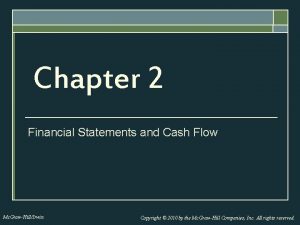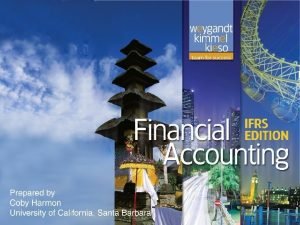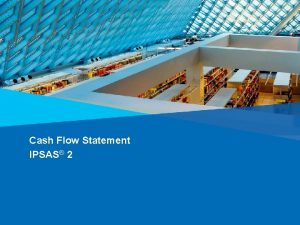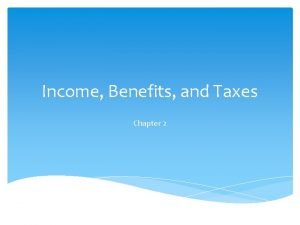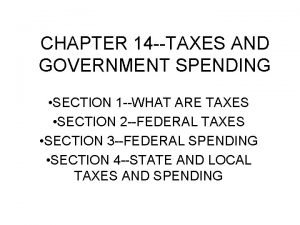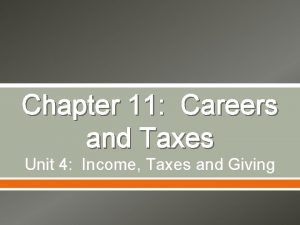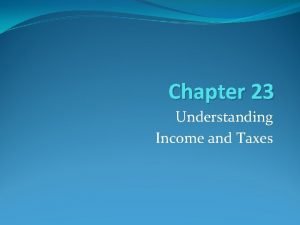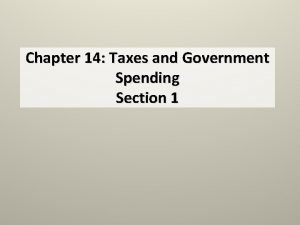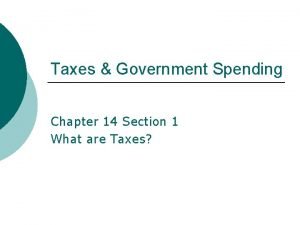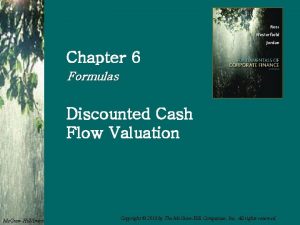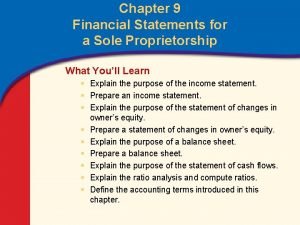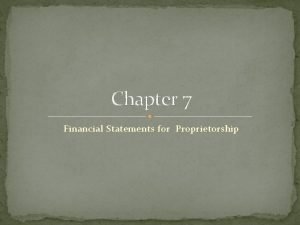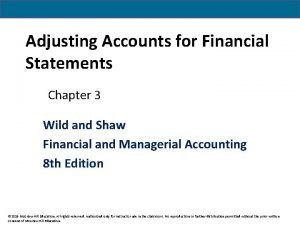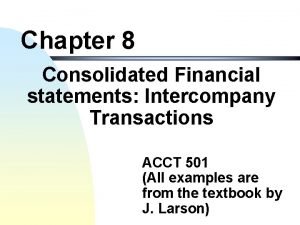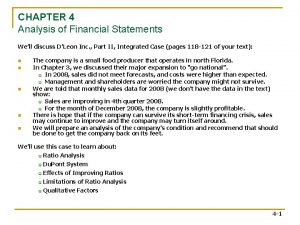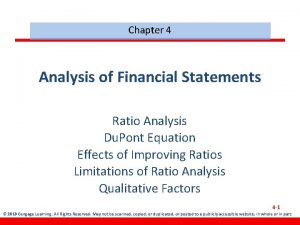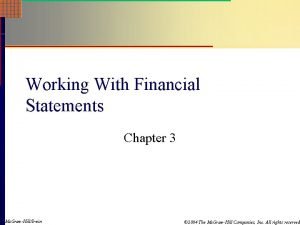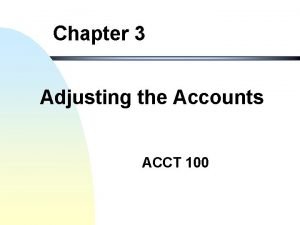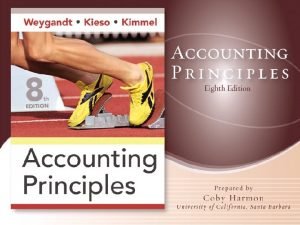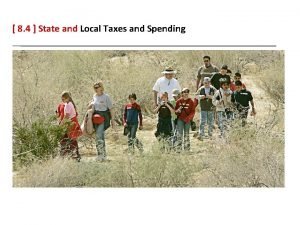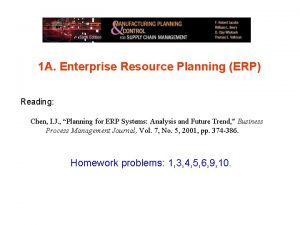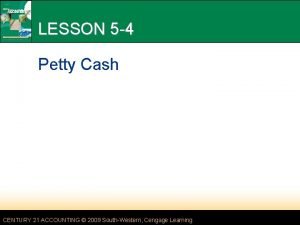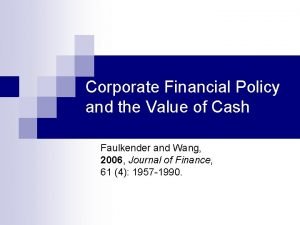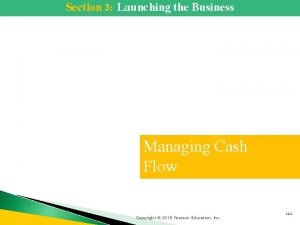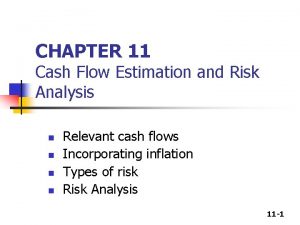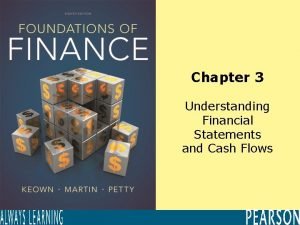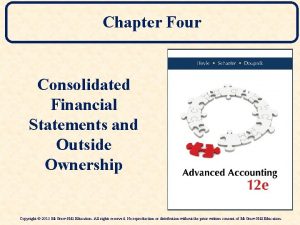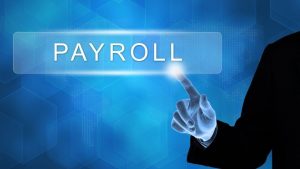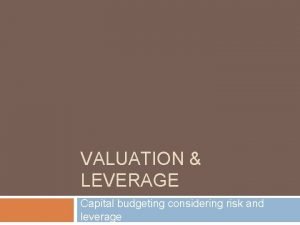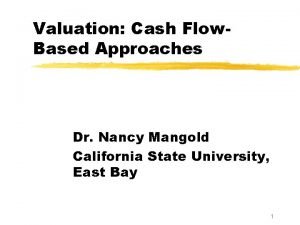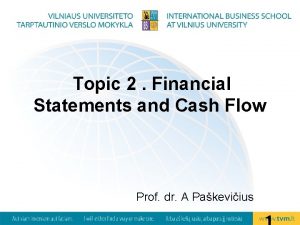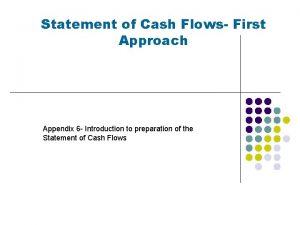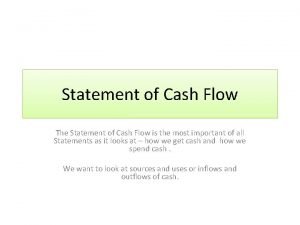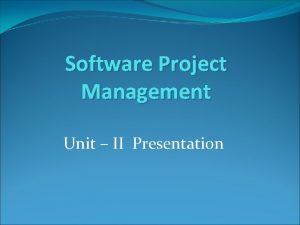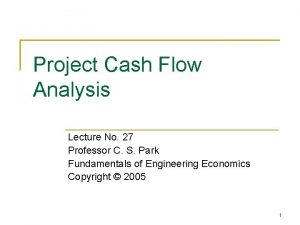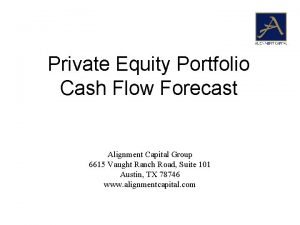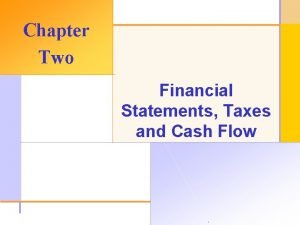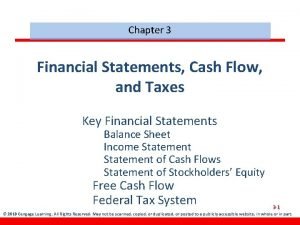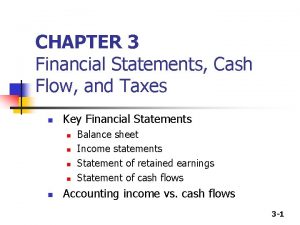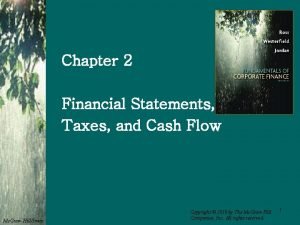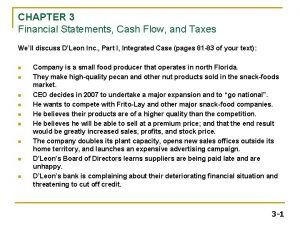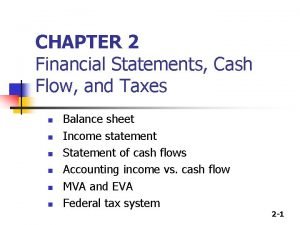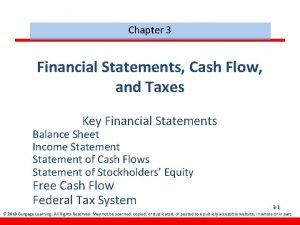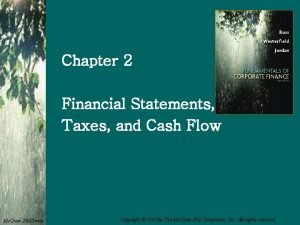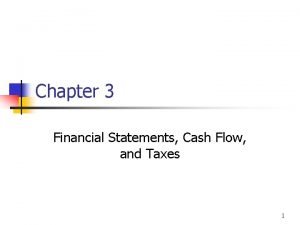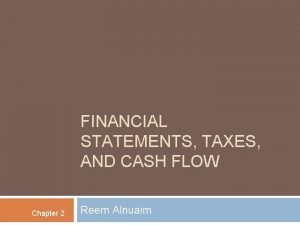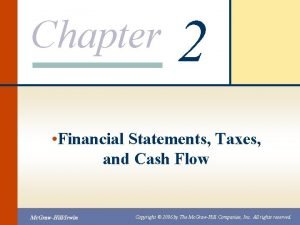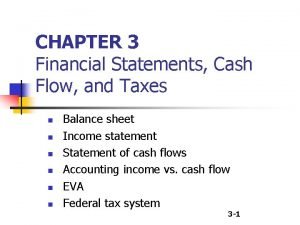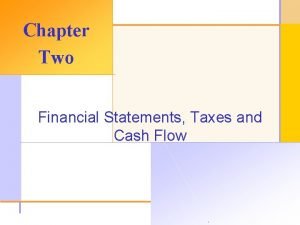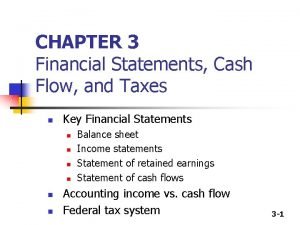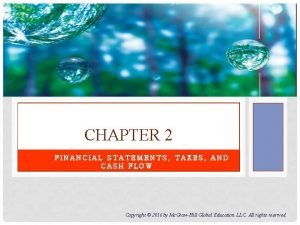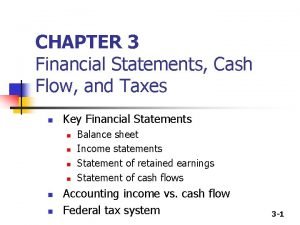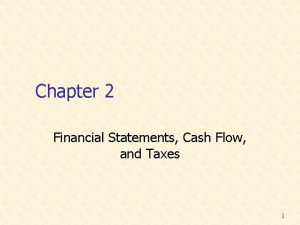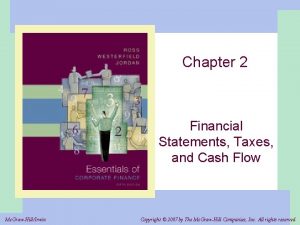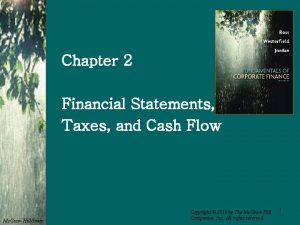Chapter 2 Financial Statements Cash Flow and Taxes



















































- Slides: 51

Chapter 2 Financial Statements, Cash Flow, and Taxes Essentials of Managerial Finance by S. Besley & E. Brigham Slide 1 of 20

Essentials of Managerial Finance by S. Besley & E. Brigham Slide 2 of 20

Financial Statements and Reports • A company’s annual report describes the operating results from the past year and new plans for the coming year with four financial statements: – Balance sheet – Income statement – Statement of changes in equity – Statement of cash flows Essentials of Managerial Finance by S. Besley & E. Brigham Slide 3 of 20

The Balance Sheet • Also referred to as the statement of financial position • Provides a snapshot of the firm’s financial position at a particular point in time • Shows assets on the left side or at the top and liabilities/equity (i. e. claims against assets) on the right side or at the bottom • Records with book values when assets are purchased or liabilities are issued Essentials of Managerial Finance by S. Besley & E. Brigham Slide 4 of 20

Balance Sheet: Assets 2013 Cash and equivalents 2012 10 15 0 65 Accounts receivable 375 315 Inventories 615 415 $1, 000 $810 1, 000 870 $2, 000 $1, 680 Short-term investments Total current assets Net plant and equipment Total assets Essentials of Managerial Finance by S. Besley & E. Brigham Slide 5 of 20

Implications on Assets • All assets are stated in dollars. • Only cash represents the actual money that can be spent. • Some marketable securities mature very soon and are called “cash equivalents” and are included with cash. • Other marketable securities have a longer time until maturity and are called “short-term investments. ” Essentials of Managerial Finance by S. Besley & E. Brigham Slide 6 of 20

Implications on Assets (cont’d) • Accounts receivable (A/R) is the amount of sales the customers have not yet paid for. • Inventory shows the dollars the firm has invested in raw materials, work-in-process, and finished goods available for sale (FIFO vs. LIFO). • Long-term assets can be reported either as gross/book value and accumulated depreciation or as net amount (the book value less accumulated depreciation). Essentials of Managerial Finance by S. Besley & E. Brigham Slide 7 of 20

Balance Sheet: Liabilities and Equity 2013 Accounts payable 2012 60 30 Notes payable 110 60 Accruals 140 130 $310 $220 754 580 $1, 064 $800 40 40 Common stock (50, 000 shares) 130 Retained earnings 766 710 $896 $840 $2, 000 $1, 680 Total current liabilities Long-term bonds Total liabilities Preferred stock (400, 000 shares) Total common equity Total liabilities and equity Essentials of Managerial Finance by S. Besley & E. Brigham Slide 8 of 20

Implications on Liabilities and Equity • Accounts payable (A/P) is an obligation the firm has to pay its suppliers for its purchases. • Notes payable represents loans the firm must repay within a year. • Accruals are the amount of taxes and wages the firm has yet to pay in a year. • Long-term bonds reflect a claim held by investors other than shareholders. Essentials of Managerial Finance by S. Besley & E. Brigham Slide 9 of 20

Implications on Liabilities and Equity (cont’d) • Preferred stock is a hybrid between common stock and debt. • Common stock account records the proceeds the firm received from selling shares of stock in the past. • Retained earnings are the cumulative amount of earnings not paid out as dividends. • The sum of common stock and retained earnings is called “common equity, ” or simply “equity, ” representing the assets net of the liabilities, or net worth. Essentials of Managerial Finance by S. Besley & E. Brigham Slide 10 of 20

The Income Statement • Show a firm’s performance over a period of time, such as a month, a quarter, or a year • EBITDA (earnings before interest, taxes, depreciation, and amortization) results from subtracting operating costs from net sales. • Depreciation and amortization are annual charges reflecting the estimated costs of the long-term assets used up each year. Essentials of Managerial Finance by S. Besley & E. Brigham Slide 11 of 20

The Income Statement (cont’d) • Neither depreciation nor amortization is paid in cash. • EBITDA can be a better measure of financial strength than net income. • EBITDA is not as important as FCF. • Net income (NI, also called profit or earnings) is revenue less expenses, taxes, and preferred dividends (before paying common dividends). • EPS (earnings per share) is net income divided by the number of shares outstanding, also called “the bottom line. ” Essentials of Managerial Finance by S. Besley & E. Brigham Slide 12 of 20

The Income Statement (cont’d) 2013 2012 Net sales 3, 000. 0 2, 850. 0 Op. costs excluding depre. & amort. 2, 616. 2 2, 497. 0 EBITDA $383. 8 $353. 0 100. 0 90. 0 $283. 8 $263. 0 88. 0 60. 0 $195. 8 $203. 0 78. 3 81. 2 $117. 5 $121. 8 4. 0 $113. 5 $117. 8 Depre. & amort. EBIT (operating income) Int. expense Earnings before taxes (EBT) Taxes (40%) Net income before preferred dividends Preferred dividends Net Income (NI) Essentials of Managerial Finance by S. Besley & E. Brigham Slide 13 of 20

Stock Price and Other Data 2013 2012 Common stock price $23. 00 $26. 00 # of shares 50, 000, 000 Earnings per share (EPS) $2. 27 $2. 36 Dividends per share (DPS) $1. 15 $1. 06 Book value per share (BVPS) $17. 92 $16. 80 Cash flow per share (CFPS) $4. 27 $4. 16 Essentials of Managerial Finance by S. Besley & E. Brigham Slide 14 of 20

What Happened to Sales and Net Income? • • • Sales increased by over $150 million. Total operating costs shot up. Interest expenses also went up. Net income was down. The firm paid less tax as a result. Essentials of Managerial Finance by S. Besley & E. Brigham Slide 15 of 20

Net Cash Flow (NCF) • Net cash flow ≠ accounting profit, as some revenues and expenses are not received or paid in cash. • NCF = NI – Noncash revenues + Noncash charges • Examples of noncash revenues/charges: – Depreciation and amortization (largest) – Deferred tax payments – Revenue not collected in cash • NCF = NI + Depreciation and amortization because other noncash items net out to zero Essentials of Managerial Finance by S. Besley & E. Brigham Slide 16 of 20

Statement of Cash Flows • Summarizes the changes in a firm’s cash position • Separates the firm’s activities into three categories – Operating activities – Investing activities – Financing activities Essentials of Managerial Finance by S. Besley & E. Brigham Slide 17 of 20

Constructing Statement of Cash Flows • Start with net income from the income statement. • Adjust net income to reflect noncash revenues (subtracting) and expenses (adding). • Calculate the changes for every account on the nearest two years’ balance sheets. • An increase in a noncash asset account decreases cash, while a decrease in such an account increases cash. • An increase (decrease) in any liability or equity account increases (decreases) cash. • Dividend payment and share buyback reduce cash. Essentials of Managerial Finance by S. Besley & E. Brigham Slide 18 of 20

Statement of Cash Flows: 2013 Operating Activities Net Income Adjustments: Depreciation Change in A/R Change in inventories Change in A/P Change in accruals Net cash provided by op. act. Essentials of Managerial Finance by S. Besley & E. Brigham $117. 5 100. 0 (60. 0) (200. 0) 30. 0 10. 0 ($2. 5) Slide 19 of 20

Statement of Cash Flows: 2013 (cont’d) Investing Activities Cash used to acquire FA Change in S-T investment Net cash provided by inv. act. Essentials of Managerial Finance by S. Besley & E. Brigham (230. 0) 65. 0 ($165. 0) Slide 20 of 20

Statement of Cash Flows: 2013 (cont’d) Financing Activities Change in notes payable Change in long-term debt Payment of cash dividends Net cash provided by fin. act. Essentials of Managerial Finance by S. Besley & E. Brigham 50. 0 174. 0 (61. 5) $162. 5 Slide 21 of 20

Summary of Statement of Cash Flows 2013 Net cash provided by op. act. (2. 5) Net cash provided by inv. act. (165. 5) Net cash provided by fin. act. 162. 5 Net change in cash ($5. 0) Cash at beginning of year Cash at end of year Essentials of Managerial Finance by S. Besley & E. Brigham 15. 0 $10. 0 Slide 22 of 20

What Can You Conclude from the Statement of Cash Flows? • The firm is not generating cash flow in its operating activities. • Net CF from operations = –$2. 5 million because of reduced net income and big increases in working capital. • The firm spent $230 million on fixed assets. • The firm borrowed heavily and sold bonds to meet its cash requirements. • Even after borrowing, the cash account fell by $5 million. Essentials of Managerial Finance by S. Besley & E. Brigham Slide 23 of 20

Modifying Accounting Data for Managerial Decisions • Unlike accountants, who are concerned with recording transactions and focus on the firm’s net income, financial managers and analysts emphasize the stream of cash flows that the firm will generate now and in the future. • More specifically, they focus on free cash flows (FCF), the cash flow available for distribution to all investors after making all investments necessary to sustain ongoing operations. Essentials of Managerial Finance by S. Besley & E. Brigham Slide 24 of 20

Essentials of Managerial Finance by S. Besley & E. Brigham Slide 25 of 20

Net Operating Profit After Taxes (NOPAT) • NOPAT = EBIT(1 – Tax rate) = Operating income × ( 1 – Tax rate) • NOPAT 2013 = $283. 8 × (1 – 0. 4) = $170. 3 million • NOPAT 2012 = $157. 8 million Essentials of Managerial Finance by S. Besley & E. Brigham Slide 26 of 20

Net Operating Working Capital (NOWC) • NOWC = Operating current assets – Operating current liabilities NOWC 2013 = ($10 + $375 + $615) – ($60 + $140) = $800 million Use (Cash + A/R + inventories) – (A/P + accruals) to try NOWC 2012. -27 Essentials of Managerial Finance by S. Besley & E. Brigham Slide 27 of 20

Operating Current Assets • Operating current assets are the current assets needed to support operations. – Op CA include: cash, inventory, receivables – Op CA exclude: short-term investments because these are not a part of operations Essentials of Managerial Finance by S. Besley & E. Brigham Slide 28 of 20

Operating Current Liabilities • Operating current liabilities are the current liabilities resulting as a normal part of operations. – Op CL include: accounts payable and accruals – Op CL exclude: notes payable because this is a source of financing, not a part of operations Essentials of Managerial Finance by S. Besley & E. Brigham Slide 29 of 20

Total Net Operating Capital (Also Called Operating Capital) • Total net operating capital = NOWC + operating long-term assets • Operating long-term assets include land, buildings, factories, equipment, and so on. • (TN)OC 2013 = $800 + $1, 000 = $1, 800 million • (TN)OC 2012 = $585 + $870 = $1, 455 million Essentials of Managerial Finance by S. Besley & E. Brigham Slide 30 of 20

Alternative to Calculating Total Net Operating Capital • Total net operating capital = Funds provided by all investors (banks, bondholders, preferred stock and common equity) – any amount tied up in short-term investments • For Micro. Drive, at year-end 2012: total net operating capital = ($60 + $580 + $40 + $840) – $65 = $1, 520 – $65 = $1, 455 million Essentials of Managerial Finance by S. Besley & E. Brigham Slide 31 of 20

Net Investment in Operating Capital • Change in total net operating capital between two years: – During 2013, Micro. Drive made: • Net investment in operating capital = (TN) OC 2013 – (TN) OC 2012 = $1, 800 – $1, 455 = $345 million Essentials of Managerial Finance by S. Besley & E. Brigham Slide 32 of 20

Free Cash Flow (FCF) vs. Net Cash Flow (NCF) • NCF is not the amount of cash flow that management is completely free to use. • FCF is the amount of cash available from operations for distribution to all investors (including stockholders and debtholders) after making the necessary investments to support operations. • FCF = NOPAT – Net investment in operating capital • Micro. Drive’s FCF in 2013 = $170. 3 – $345 = –$174. 7 million • A company’s value depends upon the amount of FCF it can generate. Essentials of Managerial Finance by S. Besley & E. Brigham Slide 33 of 20

Five Uses of FCF 1. Pay interest on debt. 2. Pay back principal on debt. 3. Pay cash dividends. 4. Buy back stock. 5. Buy nonoperating assets (e. g. , marketable securities, investments in other companies, etc. ) Essentials of Managerial Finance by S. Besley & E. Brigham Slide 34 of 20

Alternative To Calculating FCF • FCF = Operating cash flow (OCF) – gross investment in operating capital • OCF = NOPAT + depreciation • Gross investment in operating capital = net investment in op. capital + depreciation • FCF = ($170. 3 + $100) – ($345 + $100) • = $270. 3 – $445. 0 • = -$174. 7 million (same as before) • = NOPAT – Net investment in op. capital Essentials of Managerial Finance by S. Besley & E. Brigham Slide 35 of 20

Evaluating FCF, NOPAT, and Operating Capital • Is a negative free cash flow always bad? • Not necessarily; it depends on why the free cash flow is negative. • If FCF is negative because NOPAT is negative, it is a bad sign. • There is nothing wrong with a high-growth profitable (positive NOPAT) firm having a negative FCF because of making large investments in operating assets to support growth. Essentials of Managerial Finance by S. Besley & E. Brigham Slide 36 of 20

Return on Invested Capital (ROIC) • A performance measure indicating how much NOPAT is generated by each dollar of operating capital. It is one way to determine whether growth is profitable. • ROIC = NOPAT / operating capital • ROIC 2013 = $170. 3 / $1, 800 = 9. 46% • Is this enough to cover the firm’s cost of capital? Essentials of Managerial Finance by S. Besley & E. Brigham Slide 37 of 20

The Firm’s Cost of Capital Is 11%. Did the Growth Add Value? • No. The ROIC of 9. 46% is less than the WACC of 11%. Investors did not get the return they require. • Note: High growth usually causes negative FCF (due to investment in capital), but that is fine if ROIC > WACC. • Firm had high growth, negative FCF, but a high ROIC. Essentials of Managerial Finance by S. Besley & E. Brigham Slide 38 of 20

Market Value Added (MVA) and Economic Value Added (EVA) • The two performance measures developed to incorporate stock prices into traditional accounting data and modified data • MVA measures the effects of managerial actions since the very inception of a firm. • EVA focuses on managerial effectiveness in a given year. Essentials of Managerial Finance by S. Besley & E. Brigham Slide 39 of 20

Market Value Added (MVA) • A measure of the difference between the total market value of a firm and its total book value • MVA = Market value of the firm – Book value of the firm • Market value = (# shares of stock)(price per share) + Market value of debt • Total book value = Total common equity + Value of debt Essentials of Managerial Finance by S. Besley & E. Brigham Slide 40 of 20

MVA (cont’d) • If the market value and book value of debt are close, then MVA is: • MVA = Market value of equity – book value of equity • MVA = (Shares outstanding)(Stock price) – total common equity • MVA = Total market value (stock + debt) – total investors supplied capital Essentials of Managerial Finance by S. Besley & E. Brigham Slide 41 of 20

2010 Imperial Oil MVA (Assume Market Value of Debt = Book Value of Debt) • Market value of equity in 2010: – $34. 2 billion • Book value of equity 2010: – $11. 2 billion • MVA 2010 = $34. 2 – $11. 2 = $23 billion Essentials of Managerial Finance by S. Besley & E. Brigham Slide 42 of 20

Economic Value Added (EVA) • An estimate of a business’s true economic profit for the year • It differs from accounting profit. • EVA represents the residual income remaining after the cost of all capital (both debt and equity) has been deducted. • Accounting profit does not take a charge for equity capital. • EVA measures the extent to which the firm has increased shareholder value. Essentials of Managerial Finance by S. Besley & E. Brigham Slide 43 of 20

EVA (WACC = 11% for 2013) EVA = NOPAT – (WACC)(Capital) EVA = (Operating capital)(ROIC – WACC) EVA 2013 = $170. 3 – (0. 11)($1, 800) = $170. 3 – $198. 0 = –$27. 7 million EVA 2013 = $1, 800 × (0. 0946 – 0. 11) = $1, 800 × (– 0. 0154) = –$27. 7 million Essentials of Managerial Finance by S. Besley & E. Brigham Slide 44 of 20

EVA (cont’d) • EVA in 2013 was negative primarily because the amount of capital rose more sharply than NOPAT and the cost of this additional capital pulled EVA down. • EVA is typically used to evaluate managerial performance as part of an incentive compensation program. Essentials of Managerial Finance by S. Besley & E. Brigham Slide 45 of 20

Taxes • The value of a firm depends on the stream of after-tax cash flows. • Interest income and dividends are taxed in investors’ hands. • Taxes affect both corporations’ and investors’ decision making. • For example, firms prefer to use more debt than equity while investors are in favour of equity investment. Essentials of Managerial Finance by S. Besley & E. Brigham Slide 46 of 20

Key Features of the Tax Code • Corporate Taxes – Rate vary with firm size, location, and type of income being earned. • Individual Taxes – Rate are progressive. Essentials of Managerial Finance by S. Besley & E. Brigham Slide 47 of 20

Corporate Income Taxes Essentials of Managerial Finance by S. Besley & E. Brigham Slide 48 of 20

Features of Corporate Taxes • A corporation can: – deduct its interest expenses but not its dividend payments – carry back losses for the preceding 2 years and carry forward losses for 20 years* – Exclude 70% of dividends if received from another corporation, while the remaining 30% is taxed at the ordinary tax rate. *The loss treatment is to avoid penalizing corporations whose incomes fluctuate substantially from year to year. Essentials of Managerial Finance by S. Besley & E. Brigham Slide 49 of 20

Carryback and amount available for Carryforward Essentials of Managerial Finance by S. Besley & E. Brigham Slide 50 of 20

Key Features of Individual Taxation • Individuals face progressive tax rates. • Individuals are taxed on investment income as well as earned income, but with a few exceptions and modifications. • The length of time that the capital asset is held determines the tax treatment. If held for <1 year, then gain or loss is added to the other ordinary income. If held for >1 year, it is taxed at a lower rate. Essentials of Managerial Finance by S. Besley & E. Brigham Slide 51 of 20
 Flow chapter 2
Flow chapter 2 2-2 journal: financial statements and cash flow management
2-2 journal: financial statements and cash flow management Taxes payable cash flow statement
Taxes payable cash flow statement Ipsas cash flow statement
Ipsas cash flow statement Chapter 3 analysis of financial statements
Chapter 3 analysis of financial statements Financial statements and ratio analysis chapter 3
Financial statements and ratio analysis chapter 3 Chapter 2 income benefits and taxes
Chapter 2 income benefits and taxes Chapter 14: taxes and government spending section 1
Chapter 14: taxes and government spending section 1 Foundationsu.com disc
Foundationsu.com disc Chapter 23 understanding income and taxes
Chapter 23 understanding income and taxes Chapter 14 taxes and government spending
Chapter 14 taxes and government spending Chapter 14 taxes and government spending
Chapter 14 taxes and government spending Cash in cash out example
Cash in cash out example Chapter 6 discounted cash flow valuation
Chapter 6 discounted cash flow valuation Chapter 3 adjusting accounts for financial statements
Chapter 3 adjusting accounts for financial statements Chapter 9 financial statements for a sole proprietorship
Chapter 9 financial statements for a sole proprietorship Sole proprietorship financial statements
Sole proprietorship financial statements Adjusting accounts for financial statements chapter 3
Adjusting accounts for financial statements chapter 3 Chapter 8 separate financial statements
Chapter 8 separate financial statements Chapter 4 analysis of financial statements
Chapter 4 analysis of financial statements Chapter 4 analysis of financial statements
Chapter 4 analysis of financial statements Working with financial statements chapter 3
Working with financial statements chapter 3 Chapter 3 adjusting accounts for financial statements
Chapter 3 adjusting accounts for financial statements Chapter 3 adjusting accounts for financial statements
Chapter 3 adjusting accounts for financial statements Deferred tax asset journal entry
Deferred tax asset journal entry Tax loss carry forward
Tax loss carry forward State and local taxes and spending
State and local taxes and spending Cash to cash cycle time
Cash to cash cycle time Cash to cash cycle time
Cash to cash cycle time Disadvantages of master budget
Disadvantages of master budget Paid cash to establish a petty cash fund
Paid cash to establish a petty cash fund Chapter 5 cash control systems
Chapter 5 cash control systems Corporate financial policy and the value of cash
Corporate financial policy and the value of cash What are the big three of cash management
What are the big three of cash management 10-4 cash flow and budgeting answers
10-4 cash flow and budgeting answers Cash flow and cost control
Cash flow and cost control Cash flow estimation and risk analysis
Cash flow estimation and risk analysis How to calculate cash flow from profit and loss statement
How to calculate cash flow from profit and loss statement Unit 13 accounting and financial statements
Unit 13 accounting and financial statements Banking financial statement analysis
Banking financial statement analysis Partial equity method consolidation worksheet
Partial equity method consolidation worksheet Payroll tax journal entry
Payroll tax journal entry Levered free cash flow formula
Levered free cash flow formula Residual cash flow
Residual cash flow Cash flow to creditors
Cash flow to creditors Cash first approach
Cash first approach Salaries paid in cash flow statement
Salaries paid in cash flow statement Cash flow forecasting in software project management
Cash flow forecasting in software project management Discount cash flow method
Discount cash flow method Cash flow table
Cash flow table Private equity cash flow forecasting
Private equity cash flow forecasting Non operating cash
Non operating cash

